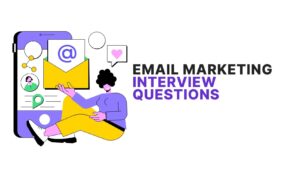Email marketing has become one of the most crucial tools for businesses to engage with their audience, nurture leads, and drive conversions. As companies rely more on personalized and data-driven communication, email marketing roles are increasingly in demand. Whether you’re just starting or you’re already a seasoned professional, landing an email marketing job requires you to ace the interview.
Understanding the key interview questions that focus on email marketing strategies, tools, and performance metrics can give you a competitive edge. This blog will cover 30 essential email marketing interview questions categorized by experience level: fresher, intermediate, and advanced. Mastering these questions will help you stand out and secure that dream role.
Why Email Marketing is Essential in the Job Market?
Email marketing is more than just sending newsletters or promotional emails. It’s about creating data-driven, personalized experiences that drive measurable business outcomes. With over 4 billion email users worldwide, email marketing remains a high-ROI channel, and businesses are increasingly seeking professionals skilled in this domain.
As a result, email marketing interview questions are now an integral part of hiring processes for marketing roles. Companies look for candidates who understand not just the basics but also advanced strategies such as segmentation, automation, and performance analysis.
Who is an Email Marketing Specialist and What Do They Do?
An email marketing specialist is responsible for designing, executing, and optimizing email campaigns that align with a company’s marketing goals. Their tasks typically include:
- Developing email campaigns for lead generation, customer engagement, and retention.
- Segmenting email lists to target specific audiences with relevant content.
- Writing compelling copy to improve open and click-through rates.
- Analyzing performance metrics like open rates, click rates, and conversions.
- Implementing A/B tests to optimize campaigns.
- Working with automation tools like Mailchimp, HubSpot, or Marketo.
Now that you have a clear understanding of the role, let’s dive into the 30 email marketing interview questions you should prepare for, divided by experience level.

Email Marketing Interview Questions for Freshers
These questions focus on the basics of email marketing and test your foundational knowledge. If you’re applying for an entry-level role, being well-versed in these areas will set you up for success.
1. What is Email Marketing, and why is it important?
Email marketing is the practice of sending targeted emails to a group of individuals or subscribers. It is important because it allows businesses to communicate directly with their audience, build relationships, nurture leads, and drive sales. Email marketing also has one of the highest returns on investment (ROI) compared to other marketing channels.
2. What are the key components of a successful email marketing campaign?
The key components include:
- Subject line: To capture attention.
- Email body content: Engaging and relevant information.
- Call-to-Action (CTA): A button or link guiding users to take the desired action.
- Visual design: Clean and mobile-friendly.
- Personalization: Tailoring content to individual preferences.
3. What’s the difference between transactional and marketing emails?
- Transactional emails are triggered by user actions (e.g., order confirmations, password resets) and provide necessary information.
- Marketing emails are promotional and aim to engage subscribers with content like offers, newsletters, or announcements.
4. How would you define an email list, and why is it crucial?
An email list is a collection of subscribers who have opted in to receive communication from a business. It’s crucial because it’s the audience that businesses engage with directly. A high-quality, engaged email list is essential for successful campaigns.
5. What is a Call-to-Action (CTA), and why is it important in emails?
A CTA is a button or link in the email encouraging the recipient to take a specific action, such as visiting a website, signing up for a service, or making a purchase. It drives conversions and moves subscribers down the marketing funnel.
6. What tools have you used for email marketing?
Some common email marketing tools include:
- Mailchimp
- Brevo
- Sender.net
- Sendinblue
7. How do you measure the success of an email campaign?
Success is measured using key metrics such as:
- Open rate: The percentage of recipients who opened the email.
- Click-through rate (CTR): The percentage of recipients who clicked on a link in the email.
- Bounce rate: The percentage of emails that were undeliverable.
- Conversion rate: The percentage of recipients who completed the desired action, like making a purchase.
8. What is an email marketing funnel?
An email marketing funnel refers to the series of emails that guide a subscriber from the awareness stage to conversion. It typically includes welcome emails, nurturing sequences, and promotional offers to encourage the recipient to become a customer.
9. What are the common reasons why emails might land in spam folders?
Emails can land in spam due to:
- Use of certain spammy keywords (e.g., “Free,” “Urgent”).
- Poor sender reputation.
- Lack of proper authentication (SPF, DKIM).
- Failure to maintain list hygiene, sending to inactive subscribers.
10. How would you segment an email list?
You can segment an email list based on:
- Demographics: Age, gender, location.
- Behavior: Purchase history, engagement level.
- Interests: Content preferences. Segmentation allows for more personalized and relevant emails.
11. What are GDPR and CAN-SPAM, and why are they important in email marketing?
- GDPR (General Data Protection Regulation) is a European regulation that ensures users have control over their personal data.
- CAN-SPAM is a U.S. law that sets rules for commercial emails, including giving recipients the right to unsubscribe. Both are important for maintaining trust and avoiding legal penalties.
Email Marketing Interview Questions for Intermediate Candidates
12. How do you create an email marketing strategy for a new product?
Start by understanding your target audience and their pain points. Then, plan a series of emails to introduce the product, highlight its benefits, offer incentives, and include a strong CTA. Use segmentation to tailor content to different customer segments.
13. What email marketing platforms have you used, and how do they differ?
Platforms like:
- Mailchimp: Easy for beginners, offers basic automation.
- HubSpot: More comprehensive with CRM integration.
- ActiveCampaign: Advanced automation capabilities. The choice of platform depends on the business’s specific needs, such as CRM integration, scalability, or automation complexity.
14. How would you improve the click-through rate of a campaign?
To improve CTR:
- A/B test subject lines and CTA placement.
- Personalize emails using dynamic content.
- Write clear and compelling copy.
- Ensure mobile-friendly design.
15. What is an email drip campaign, and why is it useful?
A drip campaign is a series of automated emails sent based on user actions or time triggers. It’s useful for nurturing leads, onboarding new customers, and re-engaging inactive subscribers. Drip campaigns keep your audience engaged over time without manual intervention.
16. Can you explain the concept of email deliverability?
Email deliverability refers to the ability of an email to land in the recipient’s inbox rather than spam or junk folders. Factors that influence deliverability include sender reputation, email content, and authentication protocols (SPF, DKIM).
17. What is a re-engagement campaign, and when would you use it?
A re-engagement campaign targets inactive subscribers who haven’t opened your emails in a while. It’s used to win back their attention with special offers, personalized content, or simply asking if they still want to receive your emails.
18. How do you handle email list hygiene?
Email list hygiene involves removing inactive or invalid email addresses to maintain deliverability. Regularly pruning your list, sending re-engagement emails, and asking subscribers to update their preferences help maintain a healthy list.
19. How would you conduct an A/B test in an email campaign?
Choose one variable to test, such as subject line, CTA, or image placement. Split your email list into two groups and send each group a different version. Analyze the results to see which version performs better, then implement the winning variant.
20. What is email automation, and how can it improve marketing efforts?
Email automation is the use of software to automatically send emails based on triggers, such as user behavior or actions. It improves marketing by nurturing leads, onboarding new users, and saving time by automating repetitive tasks.
21. What is the significance of email personalization, and how do you implement it?
Personalization increases engagement by sending tailored content. It’s implemented by:
- Using the recipient’s name.
- Customizing content based on purchase history, preferences, or browsing behavior.
22. How do you create a dynamic content email?
Dynamic content allows you to display different content blocks based on user data. For example, you might show different product recommendations based on past purchases. This is done by using tags or merge fields in your email software.
Advanced Email Marketing Interview Questions
23. How do you measure the lifetime value (LTV) of a subscriber from email marketing?
LTV is calculated by estimating the total revenue a subscriber generates over the course of their relationship with your brand. To measure LTV, analyze past purchases, average order value, and the frequency of purchases driven by email campaigns.
24. How do you integrate email marketing with other digital marketing channels?
Email marketing integrates with other channels by:
- Using social media to grow your email list.
- Retargeting email subscribers with ads on Facebook or Google.
- Aligning email content with SEO strategies to support blog traffic.
- Including email campaigns as part of an overall content marketing strategy.
25. Can you describe a time when you turned around a failing email campaign?
I had a campaign with low open rates and CTR. After analyzing the data, I found the subject lines were not engaging and the audience wasn’t segmented properly. I A/B tested new subject lines, improved the copy, and implemented proper segmentation, leading to a 20% increase in engagement.
26. How do you use customer data to personalize email campaigns at scale?
At scale, customer data can be used to segment subscribers by behavior, purchase history, and demographics. Email marketing platforms like HubSpot or ActiveCampaign allow for the use of dynamic content blocks and personalized fields, ensuring tailored emails even for large lists.
27. What’s your experience with email marketing analytics, and how do you report on ROI?
My experience includes tracking metrics such as open rates, CTR, conversion rates, and revenue per email. To report ROI, I calculate the revenue generated from email campaigns and compare it to the cost of running the campaign, including software and time invested.
28. How would you reduce the churn rate from an email marketing list?
To reduce churn:
- Focus on providing value through relevant, high-quality content.
- Use preference centers to allow subscribers to choose what type of emails they receive.
- Send re-engagement campaigns before removing inactive subscribers.
29. What advanced segmentation strategies have you used?
Advanced segmentation can include:
- RFM analysis (Recency, Frequency, Monetary value).
- Segmenting based on behavioral triggers like browsing history.
- Geographic or demographic targeting. These strategies ensure relevant messaging for each group.
30. How do you manage email campaigns during peak seasons like holidays?
During peak seasons, I plan campaigns well in advance. This includes:
- Crafting personalized offers based on past behavior.
- Running A/B tests early.
- Scheduling emails to avoid inbox overload.
- Ensuring email servers can handle higher volumes.
Also Read: How to Create an Impactful LinkedIn Profile to Attract Recruiters
Conclusion
Mastering these email marketing interview questions will undoubtedly set you up for success, regardless of whether you’re a fresher, an intermediate marketer, or an advanced professional. With email marketing continuing to play a crucial role in digital marketing strategies, understanding the nuances of campaign optimization, automation, and personalization can help you land the job you want.
By preparing for these questions, you not only demonstrate your technical skills but also showcase your strategic thinking, data analysis capabilities, and ability to contribute to the company’s broader marketing objectives.
